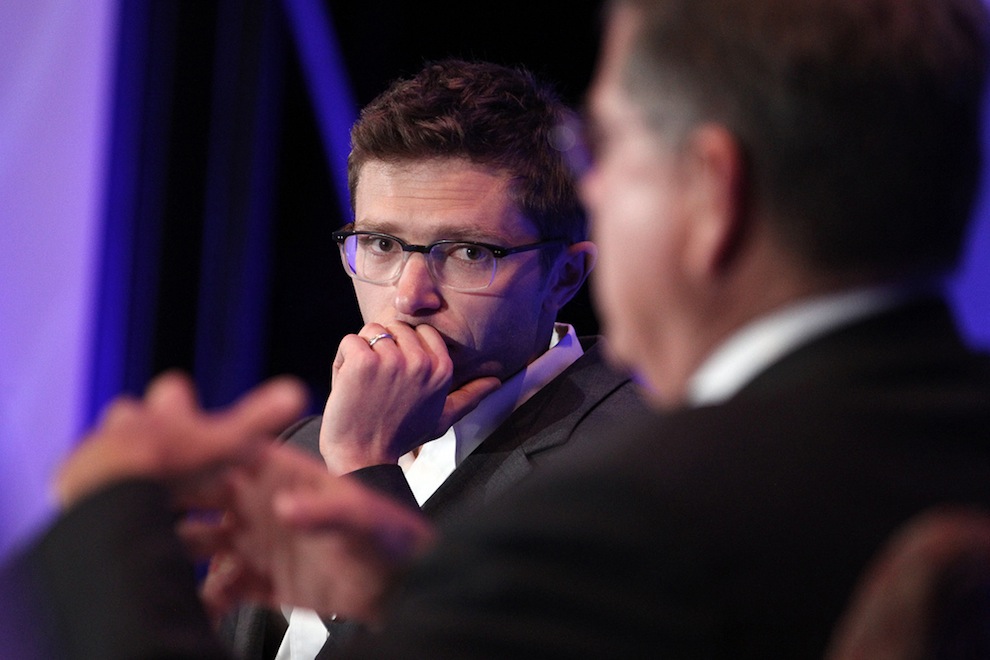
A well-funded apology: Six months after he was caught fabricating material and resigned from The New Yorker, disgraced science writer Jonah Lehrer gave his first public apology this week in the form of a speech at a Knight Foundation seminar. You can read the full text of his speech here, and Poynter’s Andrew Beaujon summarized the scenario well: Lehrer acknowledged his fabrication and plagiarism, apologized, and explained how he’s going to try to rectify the problem in the future. That only served to make his detractors (which is, right now, everyone) even angrier.
Several critics were incredulous at Lehrer’s assertion that a series of procedural safeguards would be enough to keep him from fabricating again. Forbes’ Jeff Bercovici called them “the methods of the technocrat, not the ethicist,” and Slate’s Daniel Engber said a set of procedures can’t solve Lehrer’s staggering arrogance. Poynter’s Craig Silverman delivered this point most forcefully, arguing that his plan is built to stop unintentional error, not the deliberate deception that Lehrer won’t come to grips with. “Until Lehrer is willing to face himself without props and aids, he’ll continue the pattern of self-deception and public deceit,” he wrote.
Others had different concerns: Psychology professor Christopher Chabris said Lehrer’s fabrication was tied to his fundamental misunderstanding of science. Wired’s David Dobbs asked why he hasn’t apologized to his colleagues, friends, and editors, while NYU grad student Rachel Feltman chastised Lehrer for tarnishing journalism’s (and especially science journalism’s) public perception. British journalist Kevin Anderson spoke for many of his colleagues when he said Lehrer deserves to never work in journalism again, and Gawker’s Hamilton Nolan made a more thorough argument for plagiarists and fabulists like Lehrer to be blacklisted from professional journalism. There was a dissenting voice in all of this, as the Los Angeles Times’ David Ulin said we’re betraying a bit of our sanctimony in our response to Lehrer.
After the talk, one key detail emerged that intensified the anger against both Lehrer and Knight: The foundation paid Lehrer $20,000 to give the talk. Said Forbes’ John McQuaid, “Before today, I didn’t think you could prostitute a ‘I throw myself on the mercy of the court of public opinion’ statement. I was wrong.” Amy Wallace of Los Angeles magazine wondered how Lehrer’s friends and advisors let him think taking money for a speech like this was a good idea. Taylor Dobbs of Scientific American (among others) challenged Lehrer to donate the pay, and Lehrer wouldn’t comment to Forbes’ Jeff Bercovici when asked about whether he would do so.
Of course, giving an admitted fabulist and plagiarist $20,000 for a 40-minute talk and Q&A didn’t reflect well on the Knight Foundation (disclosure: Knight is a financial supporter of Nieman Lab), either. Gawker’s Max Read castigated Knight for giving Lehrer the money, and the Columbia Journalism Review’s Curtis Brainard said he hopes news organizations have a higher standard of professional re-admission for Lehrer than Knight did. Knight’s CEO, Alberto Ibargüen, initially defended the foundation’s decision to bring in and pay Lehrer to Michael Calderone of The Huffington Post and Erik Wemple of The Washington Post, but the foundation later said it regretted the decision. Jim Romenesko pointed out that fabulist Jayson Blair was also paid (though much less) to talk about his fabrications, and published an email from Blair questioning the wisdom of Knight’s decision.

Patch and Nextdoor’s hyperlocal strategies: AOL made news a couple of times this week — once for buying the tech reviews site gdgt, and once for a better-than-expected quarterly earnings report that sent its stock price shooting up and had paidContent’s Jeff John Roberts praising its retooled ad strategy. Business Insider’s Henry Blodget pointed out the bizarre ongoing source of AOL’s profit: Its ostensibly antiquated dial-up business.
But the aspect of AOL’s report that grabbed the attention of journalism watchers was the revenue figure for its hyperlocal news project, Patch. As Forbes’ Jeff Bercovici reported, Patch’s approximately 900 sites brought in $34 million last year, less than AOL CEO Tim Armstrong had predicted. Armstrong attributed the shortfall partly to Hurricane Sandy and partly to an emphasis on cost-cutting as opposed to increasing ad sales. Ingrid Lunden of TechCrunch (also an AOL site) gave some more detail about AOL’s plans for deeper local advertising partnerships.
Entrepreneur Bernard Lunn explained why the human-powered Patch experiment is so important to cracking the hyperlocal news nut, contrasting it with the recently departed EveryBlock. At the same time, a new entrant into the hyperlocal field — Nextdoor — made a splash this week by announcing it had enlisted renowned venture capital firm Greylock Partners as an investor. As Fast Company and The New York Times explained, Nextdoor is a private (real names only) neighborhood-based social network that serves both a neighborhood watch and neighborhood Craigslist function.
Mathew Ingram of GigaOM contrasted Patch and Nextdoor’s approaches to community information, praising Nextdoor’s high barriers to entry and its fundamentally social orientation. “Instead of starting with the news and then trying to add social-networking aspects later, Nextdoor started with the social networking side,” he wrote.

Drones, secrecy, and self-censorship: The debate over drone strikes came to the forefront in the U.S. late last week thanks in part to two media reports: The New York Times and Washington Post revealed the location of a U.S. drone base in Yemen, and NBC’s Michael Isikoff reported on a leaked memo making a legal case for strikes against U.S. citizens. In the case of the former, the Times and Post had actually known about the base for more than a year, but had agreed to keep it secret for now.
In large part, both papers received not praise for breaking the story, but criticism for waiting so long. The Guardian explored some of the arguments on both sides of the decision, quoting one journalism professor who called the decision to withhold the information “shameful.” The Guardian’s Glenn Greenwald said this is part of a pattern of subservience and self-censorship on the part of the media: “Time and again, one finds the US media acting to help suppress the newsworthy secrets of the US government rather than report on them.” In addition, the Times’ own public editor, Margaret Sullivan, concluded that this case didn’t clear the bar to justifying honor a government secrecy request.
The Times’ David Carr was more sympathetic to the media in the drone debate, arguing that it has served relatively well as a site of public discussion on the issue and that it’s instead Congress that has been strangely unconcerned about the media’s drone revelations. In making his case, Carr cited a new study (PDF) by Harvard’s Shorenstein Center about the media’s drone coverage. Trevor Timm of the Freedom of the Press Foundation, meanwhile, said the drone news showed the value of leaks to democracy.
When sources fight back — with data: New York Times journalist John Broder and the electric car maker Tesla got in a fascinating spat this week over Broder’s review panning Tesla’s network of charging stations. Tesla charged Broder with falsifying information in the review, which Broder countered, and Tesla hit back with records from the car’s log data of his test drive. Broder came back with his own point-by-point rebuttal.
There was a lot to sort out here, and it’ll probably take a while before we reach any sort of conclusion. Times public editor Margaret Sullivan gave an initial review of the competing claims, while Rebecca Greenfield of The Atlantic wasn’t convinced by Tesla’s data. Techcrunch’s John Biggs looked at the role of data in these disputes, and tech blogger Dan Frommer saw Tesla’s data-backed rebuttal as a shift in the balance of power between companies and news organizations. “Many brands have established themselves as credible publishers. And why shouldn’t they be? They almost always know their industries better than the reporters covering them,” he wrote. Engadget’s Tim Stevens, meanwhile, noted that auto journalists need to get used to the idea of being watched closely when they do reviews, just as tech journalists are.
Reading roundup: There were several other stories to watch this week:
— The media conglomerate Time Warner was reported to be talking about selling much of its Time Inc. magazine division — magazines like People and InStyle, but not Time, Sports Illustrated, or Fortune — to the magazine publisher Meredith. Peter Kafka of All Things D noted that Time Warner was talking about putting its magazines up for sale last year, and The New York Times’ David Carr looked at what’s behind the sale.
— A few paywall tidbits: The currently paywall-free Washington Post is polling its users on various paywall options, The New York Times and Wall Street Journal dropped their paywalls for last week’s winter storm, the Times closed one of its easiest paywall loopholes and announced good news regarding its paywall numbers, and paidContent’s Mathew Ingram proposed a few ideas for building paywalls around people, rather than content.
— Pew’s Project for Excellence in Journalism profiled four small newspapers around the country as success stories with new business-model experiments. Rick Edmonds of Poynter, Jeff Bercovici of Forbes, and Mathew Ingram of paidContent all summarized the lessons for news organizations well.
— The Journalism Interactive conference on journalism education and digital media was held last weekend, and you can find tons of helpful ideas and tips from it with Florida j-prof Mindy McAdams’ Storify and College Media Matters’ Dan Reimold’s comprehensive summary.
— Finally, a few bits and pieces to check out: Breaking News’ Cory Bergman argued that the next big journalistic disruption is coming from mobile media, the Lab’s Ken Doctor wrote an insightful analysis of The New York Times’ ability to stop its revenue decline, MSNBC’s Ned Resnikoff explained how class affects who gets into journalism and what we see as a result, and Iowa Ph.D. student Dave Schwartz proposed a personalized breaking-news Twitter feed.